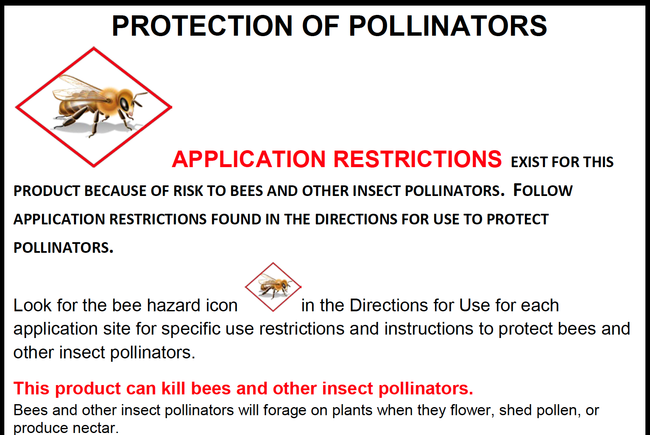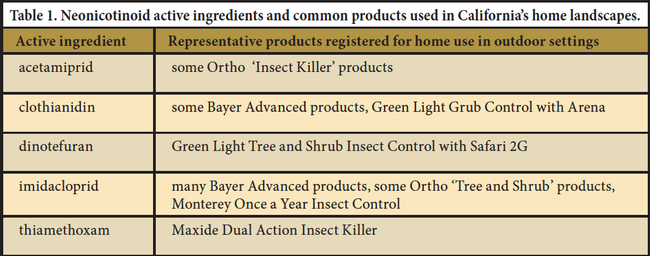[From March 2014 issue of the Retail Nursery and Garden Center IPM News.]
A massive killing of bumblebees in Oregon, concerns about impacts on honey bees, and tight new regulations imposed by the European Union have kept neonicotinoid insecticides in the news. The neonicotinoid group includes imidacloprid, one of the most popular garden insecticides sold in stores. 
First developed in the late 1980s, neonicotinoids represented the first new class of insecticides in over 50 years. They are insect nervous system toxins widely used in horticulture, agriculture, and structural settings for a broad range of pests. Desirable qualities such as reduced toxicity to people and pets (as compared to some organophosphates and carbamates) and systemic activity in plants, led to rapid and widespread use. Imidacloprid, the first neonicotinoid developed, is now the most widely used insecticide in the world (see Table 1 for other active ingredients and common product names).
The high water-solubility and environmental persistence of neonicotinoids meant they could be applied to the soil or tree trunks and taken up by the tree and translocated into leaves and stems where pest insects feed. When considering large trees or shrubs in an urban environment, this approach is clearly an efficient method of insecticide delivery. Garden neonicotinoid products are usually applied with soil drenches (Fig. 1), but professional products are often applied as soil injections, trunk injections, or bark treatments. Since leaves were not treated and pesticide drift was minimized, these types of nonfoliar applications were believed to reduce the risk to nontarget organisms.
From the beginning it was recognized that foliar applications of neonicotinoids, listed on some labels, are quite broad-spectrum in their effect and would negatively impact beneficial insects and bees. Now, however, after 20 years of use, soil and trunk applications of neonicotinoids have also been associated with serious nontarget effects and environmental contamination. Negative impacts due to neonicotinoids have been documented for earthworms, soil microorganisms, predatory beetles, bees, and parasitic wasps. Also, unexplained increases in spider mite reproductive rates in response to imidacloprid have been described.
The systemic action of neonicotinoids means that in some cases the active ingredients can be transported to a treated plant's pollen and nectar, potentially injuring pollinators and other beneficial insects. In fact, the widespread use of neonicotinoid insecticides has been cited as a possible contributor to the global honey bee decline phenomenon known as Colony Collapse Disorder.
In April 2013, European Union member states voted to forbid the application of three neonicotinoids --imidacloprid, clothianidin, and thiamethoxam-- to flowering plants. In June 2013, a mass die-off of native pollinators attributed to applications of neonicotinoid insecticides led Oregon authorities to adopt permanent restrictions on dinotefuran and imidacloprid. In August 2013, the United States Environmental Protection Agency unveiled new label language requirements and a new graphic, “Protection of Pollinators” (Fig. 2), on all products containing clothianidin, dinotefuran, imidacloprid, or thiamethoxam that are labeled for outdoor use. 
Of special interest to retail nurseries and garden centers is a 2013 study conducted by environmental advocacy groups (Pesticide Research Institute and Friends of the Earth) that found more than half of the plants, including those labeled “bee-friendly”, sampled from garden centers at national retail chain stores contained neonicotinoid residues. The report recommended that garden retailers should voluntarily demand neonicotinoid-free stock from suppliers, remove home-use neonicotinoids from their shelves, and use the opportunity to market themselves as environmentally conscious and proactive.
The water-solubility qualities of neonicotinoids create another problem in urban settings. Runoff from improperly applied soil drenches or irrigation or rain can wash these long-lived materials into creeks and stormwater systems, where aquatic organisms may be injured or killed. A study published in 2012 by researchers with the California Department of Pesticide Regulation revealed that imidacloprid was found in about half of the urban creeks sampled.
Retail products containing imidacloprid or other neonicotinoids are very popular; many are combination products that deliver a fertilizer, herbicide, or fungicide in addition to the insecticide. Improper application and improper disposal of such products may be contributing to the contamination highlighted in this article. Consumers do have choices. Most applications are made for pests such as aphids or soft scales for which other safer, effective products, such as horticultural oils or soaps, are available.
Retailers have the ability and the opportunity to act as environmental stewards by advising customers to limit the use of neonicotinoids to pest situations where there are no effective alternative tactics, delay applications of systemic insecticides until after plants have flowered, take precautions to avoid insecticide runoff into aquatic ecosystems, and follow all pesticide label guidelines.
